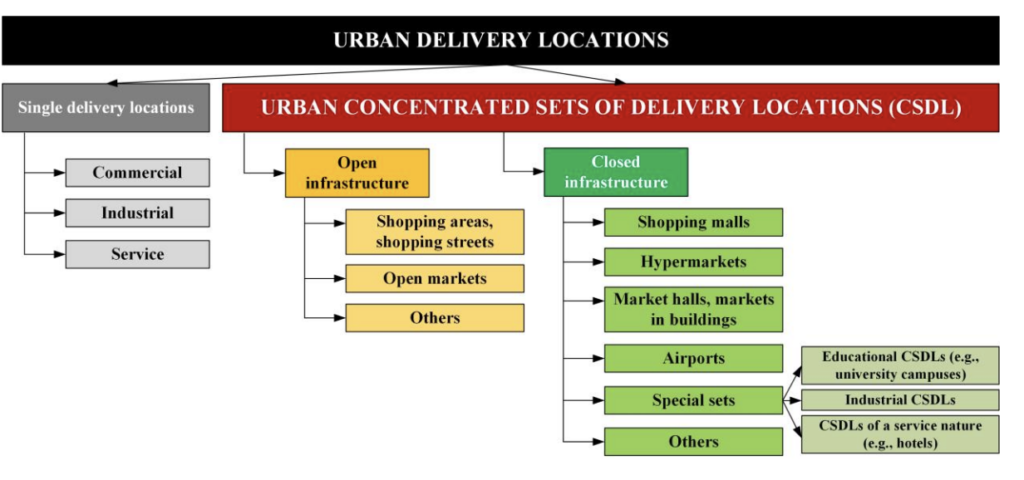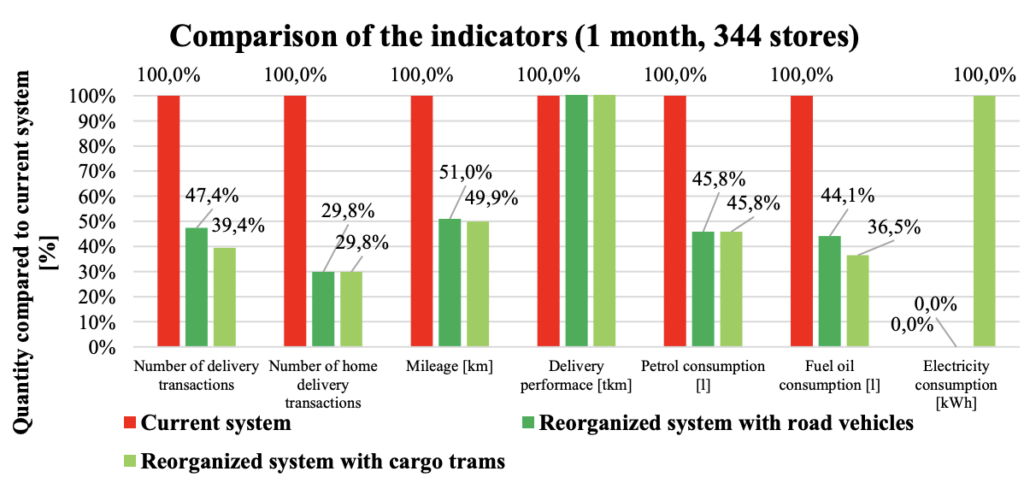A New Ph.D. thesis by Dávid Lajos Sárdi of Budapest University of Technology and Economics looked at hubs for city logistics in Budapest (Hungary). First, he looked at urban concentrated sets of delivery locations (CSDLs). Then, he presented the application of a new consolidation-based concept to the city logistics system of the CSDLs and the application of cargo bikes based on the geometrical structure of the city logistics system. Finally, he summarized the relationship between urban areas’ urban logistics development and the concentration level.
To introduce the new grouping of urban delivery locations and the term concentrated sets of delivery locations, he first examined the example of Budapest. In this case, he defined the characteristics of the clusters of delivery locations that could be interpreted as a city logistic unit. The average degree of concentration of the stores in Budapest is 47.75 stores/km2, i.e., almost 50 stores per km2. Therefore, it is worth introducing a city logistics-based clustering approach to address the significant differences in concentration between urban areas, thus facilitating related city logistics developments. He introduced a new grouping for clustering and analyzing urban delivery locations, as shown below.

As can be seen in the figure, urban delivery locations have been divided into two main groups: single delivery locations and concentrated sets of delivery locations, where several single delivery locations are handled together in some way because they are concentrated in a relatively small area, with a high concentration of demands and customer traffic. Within the latter, there are two types of concentration: CSDLs defined by open infrastructure and CSDLs defined by closed infrastructure, where the sets are organized differently.
Some data from the quantitative research:
- The 541 stores that provide a sufficiently detailed response receive 146,768 deliveries in a year, an average of 0.74 deliveries per day per store;
- these 541 responding stores receive approximately 9,300 delivery units a day;
- there is a total of 109.9 tons of goods per day in 541 stores served so far, or about 200 kg per store per day.
Concentrated sets of delivery locations: open and closed infrastructure
An open infrastructure CSDL is an area where the limits of the CSDL are not defined by a building but are surrounded by roads or squares, i.e., the road infrastructure defines the area and unifies the delivery locations within it, for example, a shopping area or a shopping street surrounded by streets or an open-air market defined by a square.
A closed infrastructure CSDL can be defined as any building-like infrastructure combining single delivery locations into a concentrated set, i.e., a building defines the boundaries of the set and unifies the delivery locations within it, such as a shopping mall, a hypermarket, or a market hall.
Consolidating deliveries
After model verification, validation, and experiment design, he compared the current city logistics system with the reorganized concepts (of consolidation-based, multi-stage city logistics systems) based on the simulation results. In the contemporary city logistics system, 6,860 delivery transactions are required to serve the 344 modeled stores in the six examined concentrated sets of delivery locations in one month, which is reduced to 3,249 transactions in the reorganized concept using trucks and 2,703 transactions by using trams. As a result, the mileage will also be reduced. In the current system, vehicles cover a total of 1,213,401 km per month, which will be reduced to 618,589 km if trucks are used in the reorganized system and 605,892 km if cargo trams are used. The cAs a result, the cost would go down by 20 to 25 percent.

Cargo bikes?
Transport costs will increase slightly for the cargo bike solution, with an increase of between 20% and 40% in the examined cases. Therefore, the direct transport solution is preferable if only the financial aspects are considered. However, if the possible effects of congestion (e.g., delayed deliveries) are also considered, the difference, which is insignificant, may be even smaller.
The development of electric vehicle technologies is expected to increase capacity and efficiency, which may also reduce transport costs. The results have shown that integrating a relatively small number of cargo bikes in the new city logistics concept could efficiently move large volumes of goods, relieving congestion on urban roads and that a slight increase in costs could be avoided in the future by increasing the efficiency of the technologies.
Source: Ph.D. thesis by Dávid Lajos Sárdi of Budapest University of Technology and Economics – Consolidation-based developments in the city logistics system of the concentrated sets of delivery locations
